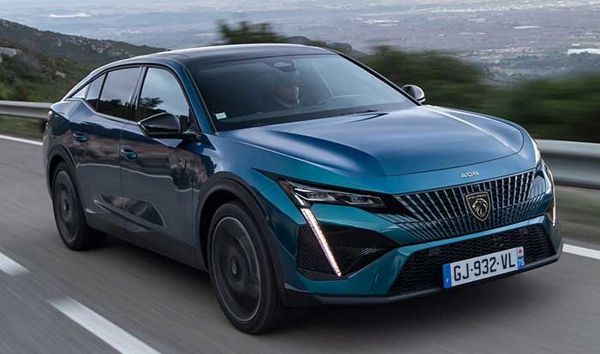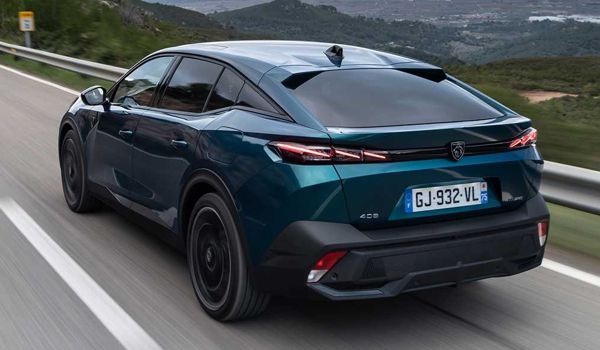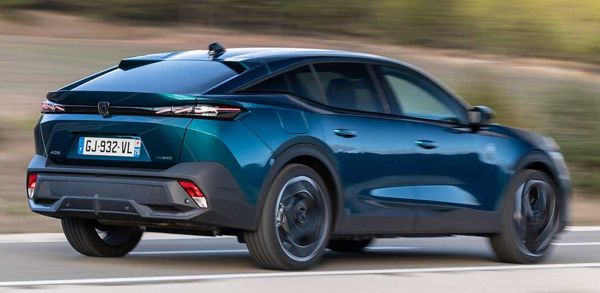Published
on 25
Nov 2022
|
All rights reserved.
|
|
|
 |
|
Peugeot uses clever styling to fool you that it was a crossover...
|
|
It might be confusing that
Peugeot has already been selling a compact sedan also called 408 in
China for many years. However, as Stellantis is withdrawing production
from China, that car won’t last long, so the 408 nameplate can go to
the new mid-sized crossover seen here.
Although it is said to be a crossover, the European 408 is more a
jacked up hatchback in my opinion, because no crossovers could be as
low as 1478 mm, or just an inch and a half taller than a 308 hatchback.
These days crossover is a strong selling point, but at the same time
cars need to cut drag in order to lower emission or extend electric
range, so Peugeot uses clever styling to fool you that it was a
crossover. 19 or 20-inch wheels, plastic cladding wheel arches and
skirts, larger ground clearance, a higher waistline but shallower
glasshouse, an upright nose with massive cheese slicer grille… all
these are design tricks that make a hatchback look like a crossover.
The overall design is quite sporty and striking, certainly more
interesting than its mechanical aspect.
 |
|
Extended
wheelbase and tail offer good cabin space and luggage room.
|
|
As suggested by its name, the 408 is positioned higher than the 308. It
sits on the same EMP2 platform, but the packaging is considerably
larger. Its wheelbase is stretched to 2787 mm, 112 mm longer than the
308. Likewise, its 4687 mm length exceeds its sister by 320 mm, thanks
in part to the longer tail. As a result, its boot offers a generous 536
liters, although that would be reduced to 471 liters if you opt for
PHEV power. The 408 actually slots between C and D-segment, which is to
say it is larger than most family hatches but smaller than conventional
family sedans or junior executive cars. However, in terms of pricing it
is right in the heartland of D-segment, especially PHEV models.
Inside, its dashboard, console, doors and almost everything are carried
over from the 308, which is no disgrace, because the latter is one of
the most premium feeling cars in its class. The i-Cockpit instrument
design is carried over intact. You either like its handy steering wheel
or hate that its rim blocks the view to instrument display. However,
the materials, fit and finish look upmarket, while infotainment system
is better than the mainstream norm. It is definitely easier to use than
Volkswagen’s system, especially as the French car leaves more physical
switches soldier on. Thanks to the longer wheelbase, a 6-footers can
sit comfortably behind another 6-footers, though the 5th passenger will
be a squeeze. Up front, you sit higher than in a hatchback, but just.
Headroom is no more generous, as the roof is not exactly high.
 |
|
Upmarket
interior shares a lot with 308.
|
|
The chassis has no frills. All models are front-wheel drive and rides
on MacPherson struts up front and torsion beam axle at the back,
including PHEV models. No adaptive dampers or hydraulic bump stops,
just typical Peugeot’s tuning know-how. The suspension setup strikes a
good balance between body control and ride comfort. Naturally, it rolls
a bit more than the 308 in corner, but it grips well and remains
stable. The steering is responsive, precise and well weighted. Decent
front-end grip ensures quick turn-in. Meanwhile, the ride is pretty
comfortable, thanks in part to the longer wheelbase. Acoustic windows
help silencing the cabin when cruising on highway.
The engine range is rather narrow, as Stellantis' European arsenal has
not many choices. The entry-level 1.2-liter 3-pot turbo might be small
and limited in power (130 hp), but it offers decent torque (170 lbft),
flexibility and refinement. Moreover, the lightweight engine benefits
handling. The mandatory Aisin 8-speed automatic is also up to the job.
 |
|
Good balance
between body control and ride comfort. Compromised powertrains.
|
|
If that’s too slow for you, the only alternative is a pair of plug-in
hybrid powertrain. Just as in other EMP2 cars, it consists of a
1.6-liter turbo four-cylinder engine and a front-mounted electric
motor. A boot-mounted 12.4 kWh battery pack offers a WLTP range of 39
miles (63 km), which should be translated to about 30 miles in the real
world. Combined output can be either 180 hp or 225 hp. Just as we found
in other cars with this powertrain, it is a compromise. The 1.7 ton
kerb weight means 225 hp feels more like 180 hp and slower than the
0-60 mph time of 7.4 seconds suggested. Meanwhile, the 180 hp version
doesn’t feel much slower, because it offers the same peak torque. The
integration of the two power sources is not the most seamless,
especially compared with Toyota’s very matured hybrid technology, and
the 1.6 engine could sound strained when being revved. The 8-speed
automatic sometimes hesitate in the transition of power sources.
Moreover, the ultra-low emission is misleading, because it doesn’t
count how electricity is generated. Also, not all people charge their
408 to full before driving. PHEV is just a transitional technology.
Fortunately, a pure electric e-408 is on the pipeline. It will offer
156 hp and 260 miles range from a 51 kWh battery.
Before a decent mid-range powertrain arrives, the 408 is hard to
recommend. Citroen C5X, also built on EMP2, is larger, more comfortable
and looks more upmarket, yet it is cheaper to buy than the Peugeot. If
you can live with Stellantis’ compromised powertrains, that will be a
better bet.
|
Verdict:    |
|